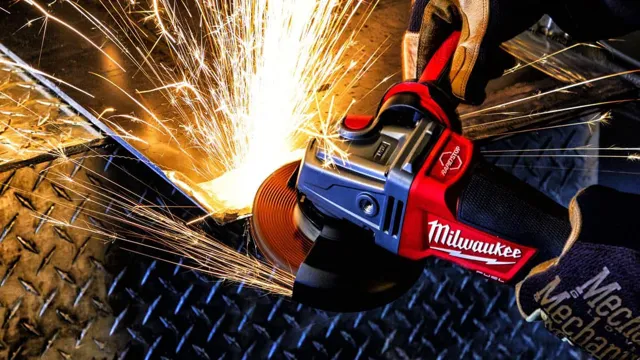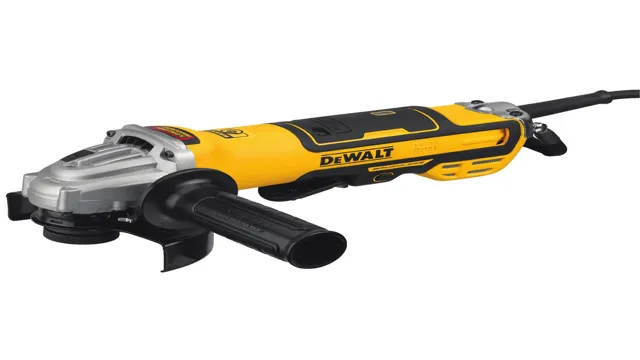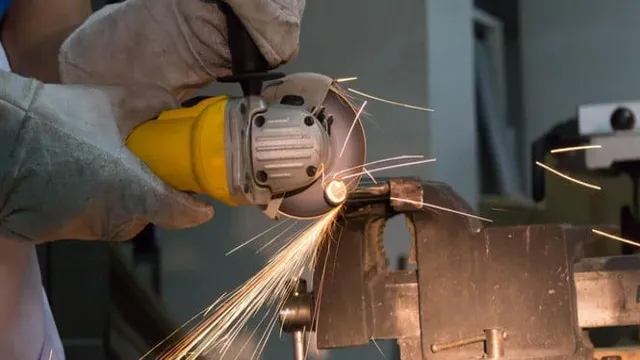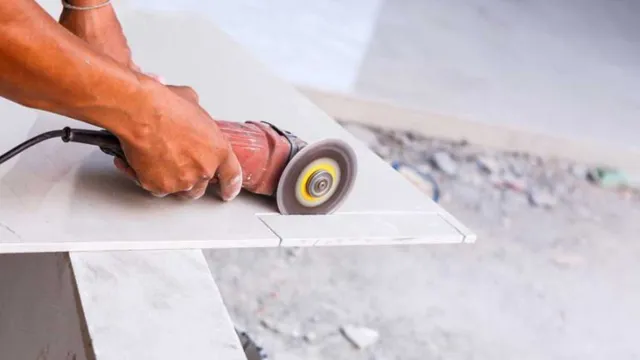Can You Cut with an Angle Grinder? Tips and Tricks for Safe and Effective Metal Cutting

Ready to take your DIY projects to the next level and up your cutting game? An angle grinder might just be the missing tool in your toolbox. This versatile powerhouse can tackle a range of tasks, from sharpening blades to cutting through metal and stone. A little unsure about tackling a cutting project with an angle grinder? Don’t worry, we’ve got you covered! In this article, we’ll guide you through everything you need to know about cutting with an angle grinder, including safety tips, suitable materials, and how to choose the right blade for your job.
So, grab your safety glasses and let’s get started!
What is an Angle Grinder?
Yes, you can definitely cut with an angle grinder! An angle grinder, also known as a disc grinder, is a handheld power tool that can be used for many different tasks including cutting and grinding. Its versatility and portability make it a popular tool for DIY enthusiasts and professionals alike. The tool works by using a spinning abrasive disc to cut through materials such as metal, tile, and concrete.
However, it’s important to note that an angle grinder can be quite dangerous if not used properly. For example, wearing appropriate safety gear such as gloves and eye protection is imperative. Additionally, choosing the correct type of disc for the material being cut is crucial.
Nevertheless, with the right precautions taken, cutting with an angle grinder can be a quick and efficient way to achieve the desired result.
Definition and Function
An angle grinder is a handheld power tool that is used to cut, grind, and polish a variety of materials such as metal, concrete, tile, and stone. It typically consists of a motor that drives a spinning abrasive disc or wheel that can range in size from 4 to 9 inches. This versatile tool is commonly used in construction and metalworking applications but can also be found in woodworking shops and DIY projects.
The angle grinder’s key function is its ability to remove material quickly and efficiently, making it an essential tool for shaping and finishing workpieces. By using the appropriate grinding accessories, an angle grinder can shape metal, remove rust, cut through concrete, and even sharpen garden tools. Its compact design and portability make it a tool of choice for tasks that require fast material removal and precision cuts in tight spaces.
So, if you’re looking for a powerful and versatile tool to take on your next project, an angle grinder might just be what you need.

Features and Types
An angle grinder is a versatile power tool that can handle several tasks around the house. It’s a handheld tool that’s designed to cut, grind, and polish materials. The tool has a motor that spins a disc, and the operator holds the tool and directs it toward the material.
There are several features and types of angle grinders available, each with its unique capabilities. Some of the features to look out for when selecting an angle grinder include the disc size, the power rating, and the speed of the tool. Additionally, there are different types of angle grinders, including corded and cordless options, and they come in various sizes for different applications.
The beauty of an angle grinder is that it can cut through just about anything, including metal, wood, and concrete. So whether you’re a professional contractor or a DIY enthusiast, an angle grinder is a tool that you should consider adding to your collection.
Materials You Can Cut with an Angle Grinder
If you’re wondering what materials you can cut with an angle grinder, the list is actually quite extensive. Angle grinders are versatile and powerful tools that can cut through metal, wood, ceramic tiles, bricks, concrete, and even stone. The type of blade you use will depend on the material you’re cutting.
For example, if you’re cutting metal, you’ll need a diamond cutting blade or a thin abrasive cutting disc. On the other hand, if you’re cutting bricks or concrete, you’ll need a thicker abrasive cutting disc. The key to using an angle grinder safely and effectively is to choose the right blade for the job and to wear appropriate safety gear, such as a dust mask, safety glasses, and ear protection.
With a steady hand and some practice, you can use an angle grinder to make clean cuts in almost any material.
Metal Cutting
Angle grinder, metal cutting, materials. If you’re looking to cut metal, an angle grinder can be a powerful tool in your arsenal. But before you start cutting, it’s important to understand which materials can be cut with an angle grinder.
The good news is, an angle grinder can handle a wide range of materials, from metal to stone and even concrete. Some of the most commonly cut metals include steel, aluminum, and brass. Each of these metals has its own unique properties, and it’s important to choose the right cutting disc for the job.
For example, steel cutting discs are typically thin and designed for cutting through thick metal quickly, while aluminum cutting discs are thicker and designed to withstand high temperatures. With the right combination of grinder and cutting disc, an angle grinder can be a versatile tool for cutting a variety of materials.
Masonry Cutting
Angle Grinder When it comes to masonry cutting, angle grinders are essential tools to have on hand. These versatile machines can cut through a wide range of materials, including bricks, concrete, and stone. To cut through these materials, you’ll need different types of discs.
For example, a diamond-tipped disc is ideal for cutting through tough materials like concrete and reinforced steel, while a masonry disc is better for cutting through softer materials like bricks and breeze blocks. Angle grinders can also be used for grinding and polishing surfaces, making them an invaluable tool to have in any construction site or DIY project. However, it’s important to always wear protective gear, such as goggles and gloves, when using an angle grinder to prevent injury.
Tile Cutting
Tile cutting can be made easier with the use of an angle grinder. When it comes to materials, an angle grinder can cut through a variety of options such as ceramic, porcelain, and stone tiles. This versatile tool can also cut through materials like metal, concrete, and bricks with ease.
However, it is important to note that the blade used in an angle grinder will need to be changed depending on the material being cut. It is essential to use the right blade for the job to ensure a clean cut and prevent any accidents from occurring. When it comes to cutting tiles specifically, it is important to use a continuous rim diamond blade as they are designed to cut through the hard surface of tiles without causing cracks or chips.
With the right blade and technique, an angle grinder can make tile cutting a breeze and allow for precise and accurate cuts.
How to Cut with an Angle Grinder
Yes, you can definitely cut with an angle grinder! It’s a versatile tool that can be used for a variety of tasks, including cutting through metal, masonry, and concrete. However, using an angle grinder can be dangerous if not done properly, so it requires some care and attention. Here’s how to do it: First, make sure you have the right blade for the job.
Then, clamp the material you want to cut securely in place, and mark out where you want to cut. Next, turn on the angle grinder and hold it with both hands, using one to grip the handle and the other to guide the blade. Slowly and steadily begin cutting along the line, being careful not to apply too much pressure that could cause the blade to bind or kick back.
Keep the angle of the grinder at around 30 degrees to ensure a smooth and even cut. When you’ve finished cutting, turn off the grinder and let the blade come to a complete stop before removing the material. With practice and a bit of patience, cutting with an angle grinder can be very effective and precise.
Safety Measures
When it comes to using an angle grinder, safety should always be your top priority. One of the essential safety measures is to wear appropriate protective gear like safety glasses, gloves, and a dust mask. Another crucial step is to make sure the angle grinder is properly secured and the wheel is in good condition before starting.
When cutting with an angle grinder, be sure to keep both hands firmly on the tool and maintain a comfortable stance to prevent accidents. It’s also crucial to avoid overworking the grinder as this can cause overheating and facilitate the risk of accidents. Lastly, never wear loose clothing around the grinder and keep the area clean and free of debris.
By following these safety measures, you can confidently and safely use an angle grinder to cut through materials like metal, tile, and concrete.
Step-by-Step Guide
Cutting with an angle grinder can seem intimidating at first, but with the right tools and techniques, it can be a breeze. Here’s a step-by-step guide on how to cut with an angle grinder. First, secure your materials and make sure they are in a stable position.
Next, choose the appropriate blade for the job and attach it to the grinder. Turn on the grinder and run the blade parallel to the material, using a back-and-forth motion. It’s important to keep the blade moving steadily and avoid applying too much pressure.
If you need to make a curved cut, simply pivot the grinder as you move along the desired shape. Don’t forget to wear proper safety gear, including gloves and eye protection. With practice and patience, cutting with an angle grinder can become second nature.
Alternative Cutting Tools
If you’re wondering whether you can cut with an angle grinder, the answer is yes! An angle grinder is a versatile cutting tool that can cut through a variety of materials such as wood, metal, concrete, and brick. However, there are also alternative cutting tools that you could use depending on what you need to cut. For example, a circular saw is great for cutting straight lines in wood while a hacksaw is best for cutting metal pipes.
A reciprocating saw, on the other hand, is perfect for cutting through thicker materials like metal and cement. Each tool has its own unique strengths and weaknesses, so it’s important to choose the right cutting tool for the job. But if you already have an angle grinder on hand, it’s worth knowing that it can do more than just grind and polish – it can cut too!
Circular Saw
Circular saws are popular cutting tools for professionals and DIY enthusiasts alike because of their accuracy and speed. However, there are several alternative cutting tools that may better suit your needs, depending on the job at hand. Jigsaws are great for cutting curves and intricate designs in wood or metal, while reciprocating saws are ideal for demolition work and cutting through thick materials like pipes and beams.
For smaller, more precise cuts, a handheld rotary tool is perfect, especially for carving and engraving. Finally, if you need to make long cuts in sheet metal or plastic, a good option is a nibbler cutter, which operates like a punch and can easily maneuver through thick materials. While the circular saw may be versatile, it’s important to consider alternatives that may make your work easier and more efficient.
Jigsaw
When it comes to cutting tools, jigsaws are a popular option for their versatility and precision. However, there are other alternative cutting tools available that can provide similar results depending on your needs. For example, rotary tools with cutting attachments can be used for intricate cuts on materials like wood or metal.
Bandsaws are another option that are great for cutting thick or long pieces of material. And if you’re looking for a more portable option, a handheld reciprocating saw may be a good choice. Each alternative cutting tool has its own strengths and weaknesses, so it’s important to consider what type of project you’ll be working on before deciding which tool to use.
By keeping your options open and exploring alternative cutting tools, you may even discover new techniques and ways to approach your projects.
Rotary Cutter
If you’re a quilter or sewer, you likely already know the benefits of a rotary cutter. It’s fast, accurate, and easy to use. But what if you don’t have a rotary cutter or are looking for an alternative cutting tool? There are a few options that might work for you.
Scissors are the most common tool, but they can be less accurate and more time-consuming. A craft knife is another option, but it can be challenging to handle and requires a steady hand. A serrated knife is a surprising alternative that might work well, especially for cutting thicker fabrics.
Another option is a pizza cutter. It may sound strange, but a pizza cutter can provide a sharp, smooth cut that makes it a solid choice for straight lines. When trying out alternative cutting tools, remember to stick with what’s most comfortable and provides the best results for your project.
Conclusion
In conclusion, the question of “can you cut with an angle grinder” can be answered with a resounding YES! However, with great power comes great responsibility. It’s important to use caution and safety precautions when operating an angle grinder, as it is a powerful tool that can cause serious injury if not handled properly. So, grab your angle grinder and get to cutting, but don’t forget to wear safety gear and make sure you know what you’re doing!
FAQs
What types of cutting discs should be used with an angle grinder for cutting different materials?
The cutting discs used with an angle grinder for cutting different materials vary depending on the material being cut. For example, a diamond cutting disc should be used for cutting concrete while a metal cutting disc should be used for cutting steel.
Is it safe to cut with an angle grinder without using protective gear?
No, it is not safe to cut with an angle grinder without using protective gear such as safety glasses, gloves, and a dust mask. The kickback and flying debris from the cutting process can cause serious injury or burns.
Can an angle grinder be used for cutting wood?
Yes, an angle grinder can be used for cutting wood, but a special cutting disc for wood should be used. The wood cutting disc has a toothed design that allows it to cut through the wood easily.
Can angle grinders be used for cutting tiles?
Yes, angle grinders can be used for cutting tiles, but a diamond cutting disc should be used for this purpose. The diamond cutting disc is designed to cut through the hard ceramic or porcelain surface of the tiles.
Are there any safety tips that should be followed while using an angle grinder for cutting?
Yes, some safety tips that should be followed while using an angle grinder for cutting are: wear protective gear, keep fingers and hands away from the cutting area, ensure that the workpiece is properly secured, and do not force the cutting disc.
Can an angle grinder be used for cutting concrete?
Yes, an angle grinder can be used for cutting concrete, but a diamond cutting disc should be used for this purpose. The diamond cutting disc is designed to cut through the hard, dense material of the concrete.
What is the recommended RPM for cutting with an angle grinder?
The recommended RPM for cutting with an angle grinder varies depending on the size of the cutting disc and the material being cut. It is important to refer to the manufacturer’s instructions for the recommended RPM for each specific cutting disc.




